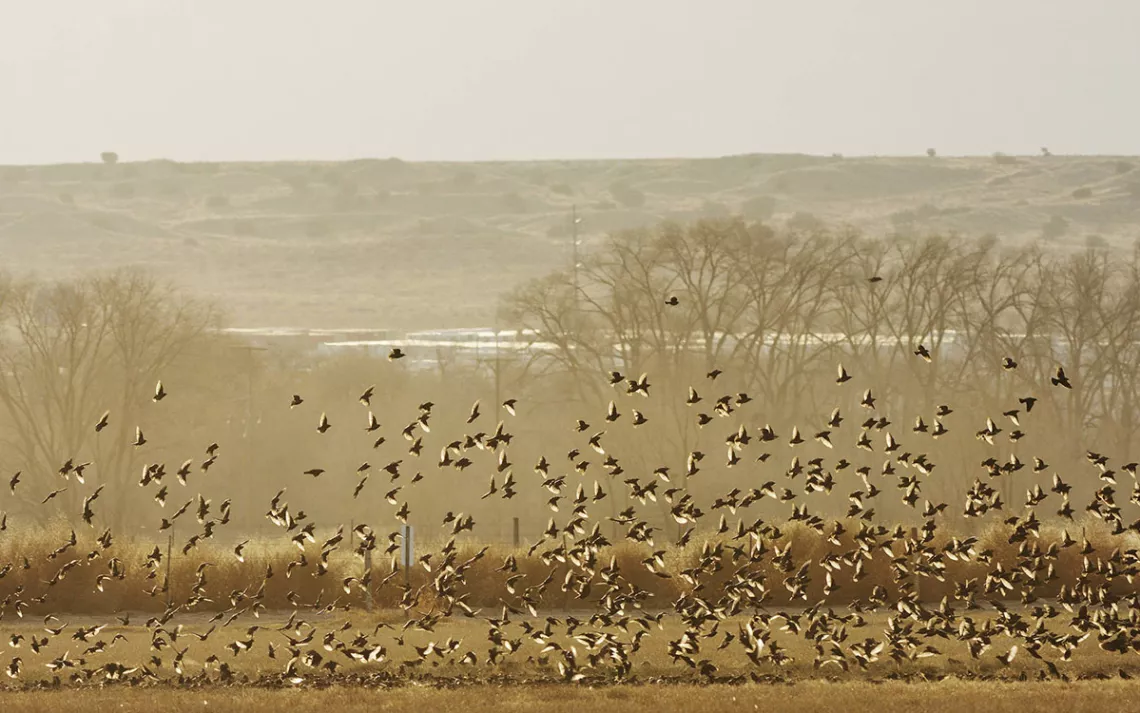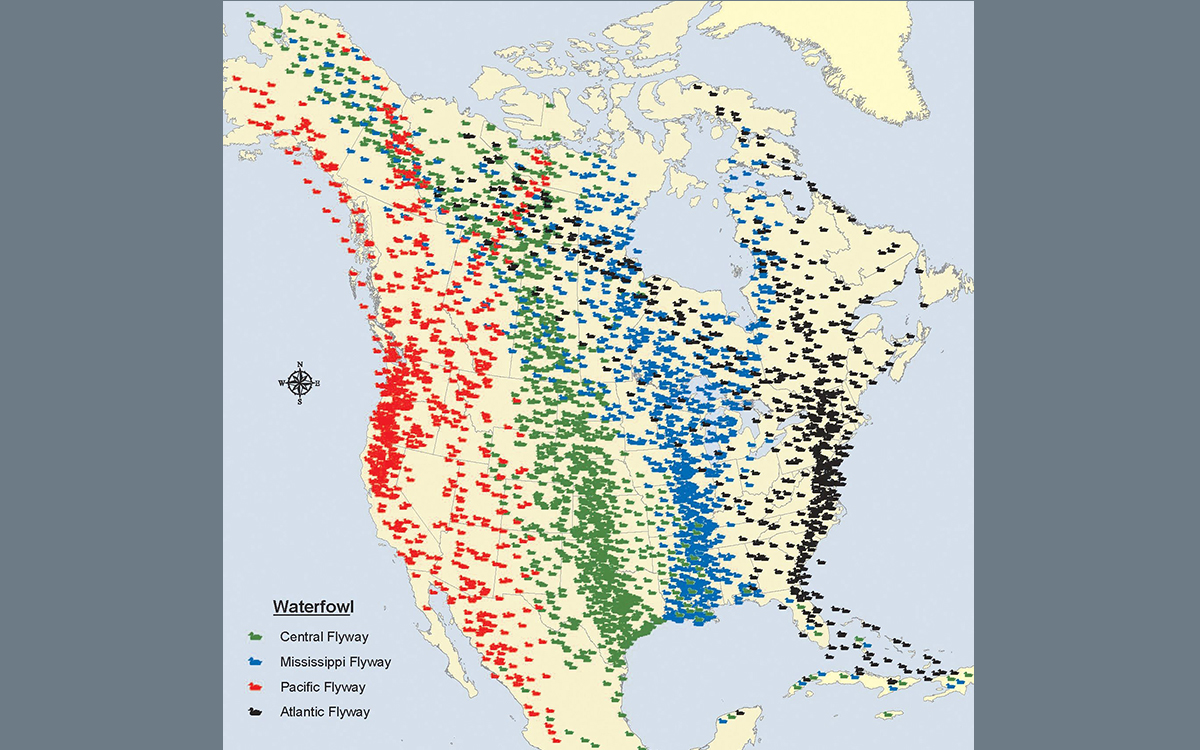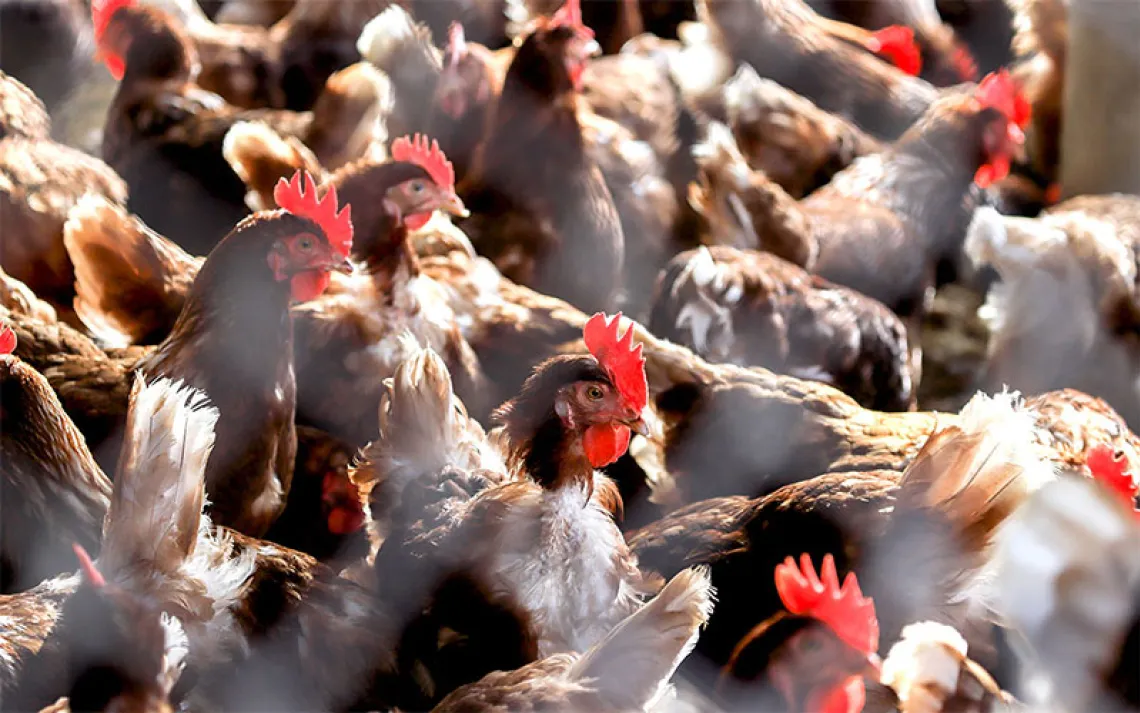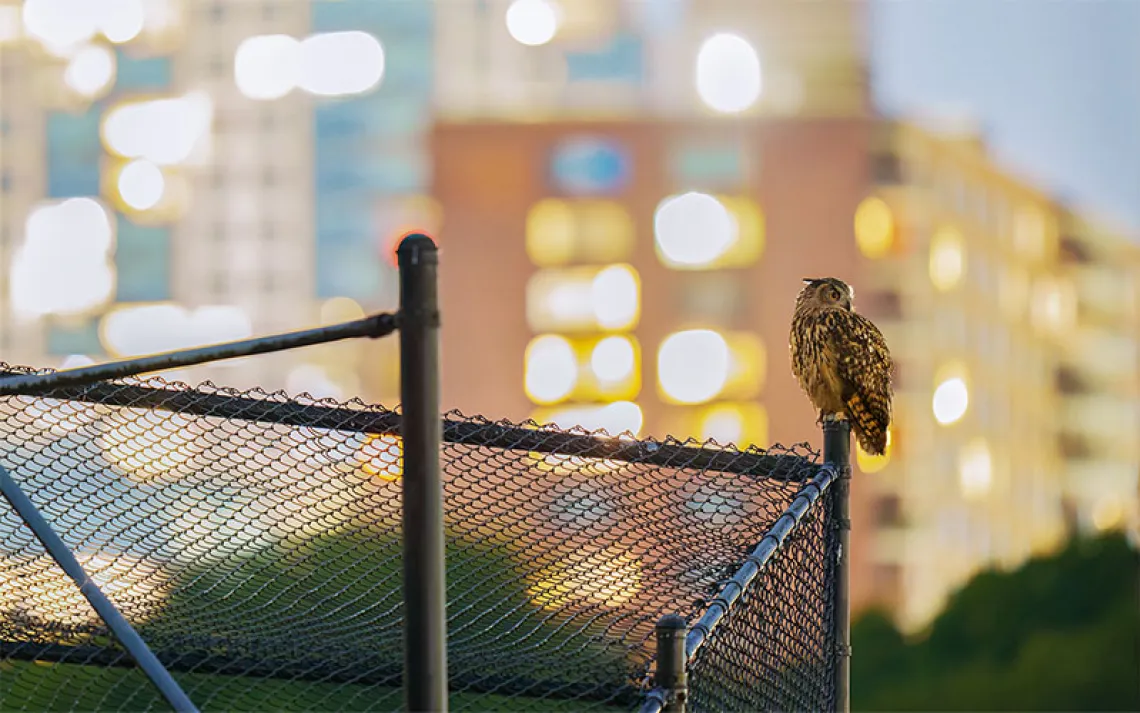Fall Birding Tips
It’s migration season, and birds are on the move. Here’s how you can best observe them.

Birds take flight from a field at Valle de Oro National Wildlife Refuge, New Mexico. | Photo by Wenshu Chen
When I first became aware of the quiet flight calls of migrating songbirds, it made those calm, starry September nights magical. I couldn’t sleep for the subtle chips and chirps of flocks of warblers, sparrows, and thrushes winging invisibly overhead. The thought of these tiny travelers navigating by the stars, driven by powerful biological urges across incredible distances captured my imagination and drove my progression from casual birder to enthusiast.
Like many others, my bird identification skills improved rapidly when I downloaded Cornell University’s Merlin app for my smartphone. Merlin’s audio recognition function helped me pick out species by sound, enhancing my knowledge even when I only catch a glimpse of a singing songbird through binoculars. With Merlin’s support, my birding skills grew with my life list, adding joy to my everyday walks in urban green spaces and on backcountry canoe trips.
The dynamic fall migration is something else altogether. With the influx of young birds hatched and reared over the summer, “the size of [fall] flights can be spectacularly large,” says Andrew Farnsworth, a migration ecologist and visiting scientist at Cornell. Birds start gathering in mixed flocks in mid-to-late summer, preparing for long-distance flights. When it’s time to go, most species fly by night, taking advantage of cooler temperatures and lighter winds. They issue soft, barely discernible calls among themselves to stay oriented—behaviors that ornithologists like Farnsworth are studying. Farnsworth estimates the number of autumn night fliers crossing US airspace at an astounding 4 to 5 billion. Meanwhile, soaring species like raptors rely on daytime thermal winds to travel long distances.
Come morning, most migrating songbirds will seek out food and shelter, making it an ideal time for closer observation. Visual identification of many species, however, is more difficult at this time of year, because many juvenile fall migrants lack the colorful plumage of their elders. What’s more, with the breeding season long past, birds have no need to issue their telltale, territory-defining serenades that allow birders (and the Merlin app) to make definitive species identifications. “Some people prefer the striking and colorful plumages of spring birds,” Farnsworth says, “but the fall birds' complexities and subtleties are equally beautiful, and there's much to be said in highlighting the excitement around these colors and the challenges in ID.”
While spring birding tests your ears, fall challenges your skills in visual observation, demanding more careful observations of small details. Once you learn a few tricks, it’s possible to tally dozens of migrating species in a single flock when birds touch down in thickets, treetops, and along coastlines and waterways for well-deserved rests during their long journeys.
A lengthy season
The fall migration is more drawn out than that in spring because birds aren’t rushing to stake out breeding territories and reproduce in the short window of a northern summer. Come fall, they can patiently wait for the best weather to fly. Peak migration occurs between August and October across much of North America, with a few exceptions. Long-distance migrants like Arctic breeding shorebirds, including species of sandpipers, start their migrations in July, with stopovers to refuel along the Great Lakes and along the Atlantic seaboard en route to South America. Shorter-distance migrants like raptors, waterfowl, and seabirds—as well as some species of sparrows—make their journeys in November and December. Mature birds tend to head south sooner, while younger birds take longer to fly—according to Farnsworth, “presumably gaining experience, developing feathers, bulking up, and imprinting and learning environmental cues like celestial patterns and magnetic fields to help them find natal grounds the following year.” This is particularly evident in common loons, with young of the year often waiting for the winter’s first ice on the canoe country lakes of Minnesota and Maine before venturing south, weeks after their parents have departed.
Coming in for a rest
After a long night’s journey, birds seek out places to rest—pockets of trees and shrubs, or shorelines and wet areas—before taking to the air once again. Places like Cape May, New Jersey, are renowned destinations for dawn birding as thousands of birds come to land, starving and less shy of human observers, allowing for lengthy observations. Urban parks, ponds in agricultural areas, and backyard gardens can be similarly attractive stopovers.
Tech-free ID
“Identification is sometimes only as hard as we make it in our heads,” insists Farnsworth. “Spend time reviewing photographs in eBird or in field guides before going in the field, learn the common species that occur in your area, and get comfortable in knowing what's different. Be observant about patterns of feathers on wings, back, undertail, and cues on different areas of birds' plumages to learn the patterns. The patterns can be subtle, but they are equally distinctive if you spend time recognizing this is the case and you don't need to be confused.”
Some fly by day
Migration behavior is dictated by birds’ physiology. “Flapping” fliers like songbirds save energy by moving in calmer nighttime conditions. Soaring species, however, depend on thermal winds to cover long distances—often at altitudes that make them barely discernible to the human eye. Diurnal migrants like raptors migrate by “leading topographic lines,” explains Farnsworth, often tracing north-south landforms like ridges, peninsulas, and coastlines on sunny days. Hawk Hill in the Marin Headlands north of San Francisco is a favorite spot to watch migrating raptors, as they cross San Francisco Bay at its narrowest point, the Golden Gate. One of Farnsworth’s most memorable moments was seeing over 30,000 migrating raptors high above the Audubon Center in Greenwich, Connecticut.
The forecast of migration
Weather plays a huge role in the migration. Moderate winds and gusty conditions keep most songbirds grounded. In continental areas, the greatest concentration of migrating birds tends to occur a day after the passage of a cold front, when air flow shifts to the north and migrants benefit from clear skies and tailwinds. Similarly, cold fronts tend to produce westerly winds on the Pacific coast, blowing in offshore migrating seabirds. Farnsworth worked closely in the development of BirdCast, an online tool that forecasts spring and fall bird migrations in real time based on weather patterns. The onset of fog and low clouds can trigger great sighting opportunities when birds come into land to reorient themselves.
Turn out the lights
Birds are among the greatest casualty of the extinction crisis because they rely on a range of habitat across vast geographies. Populations of red knot, an athletic shorebird that travels between the high Arctic and South America, have crashed by 90 percent in the past decade as critical refueling habitat on the East Coast has deteriorated. Supporting broad, continent-wide conservation strategies, lobbying to protect Important Bird and Biodiversity Areas, and contributing to citizen science efforts like eBird are the best things you can do to preserve the wonders of birding for future generations. At a local level, Farnsworth says, it’s important to minimize light pollution, use bird-safe glass to reduce collisions, keep cats indoors, and create bird-friendly backyards with native plants.
Gear up

Sign up to receive Sierra News & Views
Get articles like this one sent directly to your inbox weekly.
With this action you affirm you want to receive Sierra Club communications and may vote on policy designated by the Sierra Club Board.
Witnessing the intricate details of a songbird through high-quality binoculars is a revelation, especially combined with the satisfaction of overcoming the challenge of first detecting movement of a fist-sized (or smaller) creature in thick woods or noticing a crane soaring thousands of feet overhead. The US-designed Maven B.7 ($600-625, mavenbuilt.com) is the most compact, backpacker-friendly version of Maven’s premier B-series optics, offering an incredibly bright view and competitive factory-direct pricing. Choose the 8x version for greater versatility in the field. David Allen Sibley is renowned for his lavishly illustrated field guides, and his recent What It’s Like to Be a Bird provides interesting insights into birds’ habits and lives. Meanwhile, the simple and light Wy-east Daypack by Six Moon Designs ($155, sixmoondesigns.com) is a practical backpack for adventure birding.

Migratory bird flyways in North America. | Handout Photo North Dakota Game and Fish Department
In general, migrations occur along four major geographical flyways in North America:
The Pacific Flyway stretches from Alaska to the Baja Peninsula, and inland as far as the Rockies.
- Starting in August, American avocets and black-necked stilts mark the beginning of the fall migration season at Utah’s Great Salt Lake. Grebes and other ducks arrive in September, followed by migrating red-winged blackbirds in October.
- Don Edwards National Wildlife Refuge provides an oasis for 280 species of birds, including white pelicans and white-tailed kites, amid the sprawl of Silicon Valley, at the southern end of San Francisco Bay.
- Tide flats and salt marshes at Grays Harbor National Wildlife Refuge near Hoquiam, Washington, provide refuge for sandpipers, dunlins, dowitchers, and other shorebirds. Watch for western species of warblers and other songbirds in the willow shrubs and deciduous forests just inland.
The Central Flyway encompasses the Canadian high Arctic southward to the Great Plains through Texas.
- Wetlands in the Prairie Pothole Region of the northern Great Plains, spanning the Dakotas, Montana, Minnesota, and Iowa, support more than 50 percent of North America’s migratory waterfowl, including pintail ducks and blue-winged teal.
- The Texas coast is a hot spot for birding. Watch for soaring raptors, shorebirds, and diminutive songbirds waiting out the weather to the Gulf of Mexico en route to wintering grounds in the Caribbean and Central America.
- The urban lakes and mixed wood forests of Minneapolis are stopovers for countless nocturnal migrants moving southward from breeding habitat in Canada’s boreal forest. Watch for red-eyed, blue-headed, and Philadelphia vireos, as well as palm warblers, Swainson’s thrush, and many more species of songbirds throughout September.
The Mississippi Flyway funnels birds south from Hudson Bay and most of the Great Lakes to the Gulf of Mexico.
- The sweeping sand beaches of Whitefish Point, Michigan, greet migrating raptors like red-tailed hawks and peregrine falcons after soaring across Lake Superior. Like other peninsulas in the Great Lakes region, Whitefish Point also serves as a layover for many songbirds and shorebirds.
- An easy walk through the Chicago Botanic Gardens reveals the importance of urban greenspace in supporting migratory birds. You’ll see long-distance migratory songbirds like vireos and warblers in September and shorter-distance travelers like ducks, raptors, and sparrows through November.
- The Wapanocca National Wildlife Refuge in Arkansas is described as an “island of forest in a sea of agriculture,” making it a major stopover for neotropical songbirds, including prothonotary warblers and yellow-billed cuckoos.
The Atlantic Flyway extends from Newfoundland and Labrador to Florida, including Lake Erie and Lake Ontario.
- Manhattan’s Central Park provides some of the best urban birding in the world, with 268 recorded species. Eastern whip-poor-wills and American bitterns are among many fall migrants that rely on this urban oasis.
- Hawks and other raptors soar high over the Appalachians in Pennsylvania’s Hawk Mountain Sanctuary, west of Allentown.
- Cape May, New Jersey, and Delaware Bay are renowned birding destinations, with mudflats and salt marshes serving as a critical stopover for over 1 million shorebirds, including red knots. Diurnal migrants like ospreys, merlin, and species of hawks soar overhead, and hundreds of species of songbirds like warblers come into rest.
BirdCast offers daily, state-by-state, county-by-county forecasts of bird migrations.
 The Magazine of The Sierra Club
The Magazine of The Sierra Club



